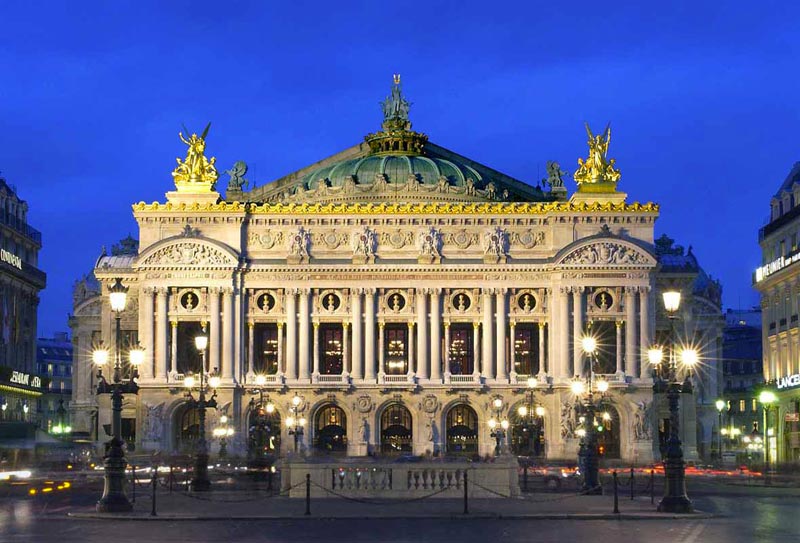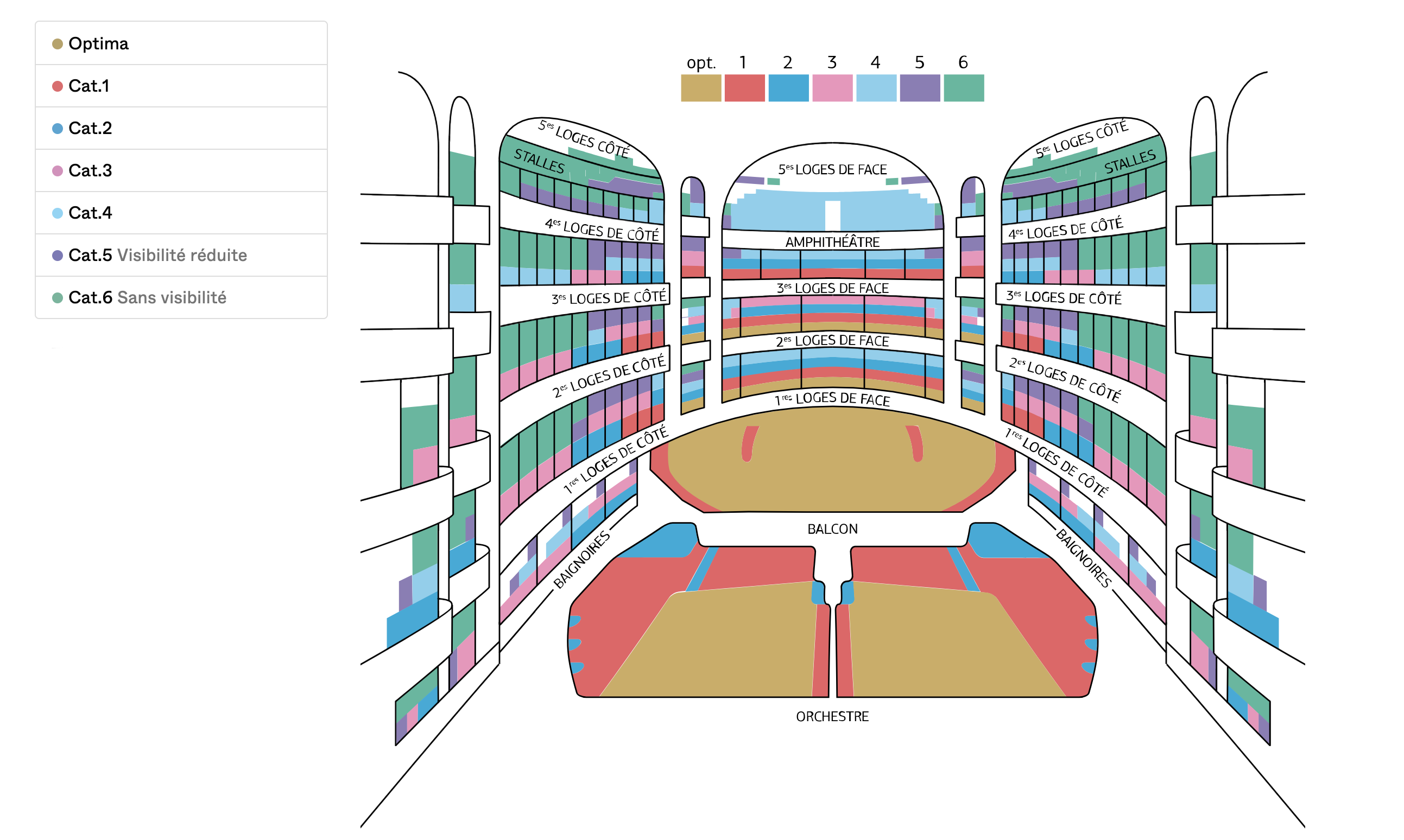Yvonne, Princesse de Bourgogne

Location
Place de l’Opéra 75009 Paris
Capacity 1900 seats
Duration
2 hours and 35 minutes
1 intermission
Details
Opera
Recommended for all ages
French with English & French subtitles
Highlights: Yvonne, Princesse de Bourgogne
Story: Yvonne, Princesse de Bourgogne
Reviews
Opéra Palais Garnier
History and Fun Facts about the Opéra Palais Garnier
One of the most prestigious stages in all of France, the Palais Garnier was constructed between 1860 and 1875, designed by legendary architect Charles Garnier, who was selected among a handful of talented architects in a fierce design competition. The building itself is considered an artful masterpiece, and was one of the most expensive construction projects to come from the Second French Empire under the reign of Napoléon III. The elaborate use of different materials to lend a lavish multicolored facade was typical of many of the works under the rule of Napoléon III, and features sculptures of various figures of Greek mythology. The official inauguration in 1875 was attended by the Mayor of London and Amsterdam, the King Alphonso XII of Spain, and hundreds of members from European high society.
The interior was meticulously designed with intertwining corridors, alcoves and landings to allow for easy movement of large numbers of people; complete with a grand marble staircase and the grand foyer, acting as the drawing room for all of Paris high society and covered in gilded paintings. The auditorium itself is in a traditional Italian horseshoe shape, seating 1900. The stage is the largest in Europe and can accommodate 450 artists, revealed by the opening of the legendary painted curtain. Garnier himself designed the 7-tonne chandelier sparkling above the audience. In 1896, one of the many chandelier counterweights broke free and killed a concierge, the incident that inspired the scenes in the 1910 novel-turned-musical The Phantom of the Opera. The space above the auditorium in the copula dome was once used strictly for cleaning the chandelier, but has since been transformed into a space for opera and dance rehearsals.
The legendary building was initially deemed the Academie Impériale de Musique, yet with the fall of the Second Empire and the start of the Third Republic, this was aptly changed for the Academie Nationale de Musique, which we see written across the exterior facade to this day. Garnier envisioned his design and the transformation of the surrounding area, and to this day the opulence of the Second Empire lives on in this living monument. The avenue de l'Opéra remains the only large Parisian corridor without trees, as Garnier explicitly prevented Haussmann from adorning the street with trees, arguing that his Palais Garnier was to be the main focus. Palais Garnier became the official name in 1989 with the construction of the Opéra Bastille, and the venue now houses primarily ballets.
Fast facts
Capacity: 1,979
Handicap Accessible: Yes – in order to guarantee access to specific locations, we ask that you make your reservation at least 15 days before the performance.
Air conditioning: Yes
Heating: Yes
Coat Check: Yes (free service)
FAQ
Where will I be seated and will I see the subtitles properly?
There are a maximum of three categories available, each of which provides a comfortable view of the subtitles. The theatre is an Italian style auditorium, meaning the seats are in a horse-shoe shape. Theatre in Paris guests are centrally placed either in the orchestra, on the first level/mezzanine, or in the second, third, and fourth level lodge boxes to have an optimal view of the stage and subtitles.
How do I get to the theatre?
The theatre is accessible by the metro station Opéra (Lines 3, 7, 8 and RER A). Our hotline can be reached in case of difficulty finding the theatre weekdays from 10 am to 7pm Paris time. For details, we invite you to consult the map above.
What do I do when I get to the theatre?
We invite you to arrive 20 minutes before the beginning of the show, and present your voucher at the front desk. The theatre's English-speaking staff members will guide you to your seats. Please note that the performances at the Palais Garnier begin precisely on time, and all late arrivals will not be permitted to enter the auditorium until intermission.
How long does the show last?
The show lasts two hours and thirty-five minutes, including one intermission.
Is it a show for travellers or French people?
Both! The Palais Garnier has been welcoming audiences from all over the world for close to 150 years. This legendary opera performance is sung in its original French, and subtitles in both French and English are provided for audiences to appreciate in one of France’s most iconic venues.
Subtitles or “surtitles”?
Surtitles (also called supertitles) are the theatre equivalent of subtitles or as others may know it, captioned performances. That’s because in French “sur” means “above”. At the Palais Garnier, the text is projected both on the sides of the auditorium, and centrally directly above the stage.
Does the venue have a specific dress code?
For Parisian operas and ballets, the dress tends to be a bit fancier than in other venues, so feel free to have a little fun and dress to impress. Many Parisians will arrive directly from work, dressed in casual chic attire. Generally, elegant casual wear is required, jackets are recommended for men. Shorts, Bermuda shorts, flip-flops, sportswear and trainers are discouraged.
Is there a coat check available?
Free cloakrooms are available on various floors of the theatre. Travel bags and suitcase are not allowed.
Can I take photos of the performance?
In order not to disturb the artists on stage, and for the comfort of other guests, you are not permitted to photograph, film or record the performance for the duration of the show. As long as the performance is not currently in session, feel free to take a snapshot of the wonderful venue to remember your night out!
What is included with my tickets?
A dedicated show programme, a complimentary glass of champagne, and exclusive access to the beautiful Salon Liebermann is included with your tickets.
Where do I collect my show programme and champagne?
At the Opéra Garnier, you can collect your included show programme in the main store, at the programme stand in the entry hall, or at the programme stand at the bottom of the Grand Staircase.
You can choose to enjoy your champagne or desired beverage before the performance or during intermission at any of the public bars or in the exclusive Salon Liebermann. The Salon is located on the right-hand side of the Grand Foyer, behind the fireplace.







